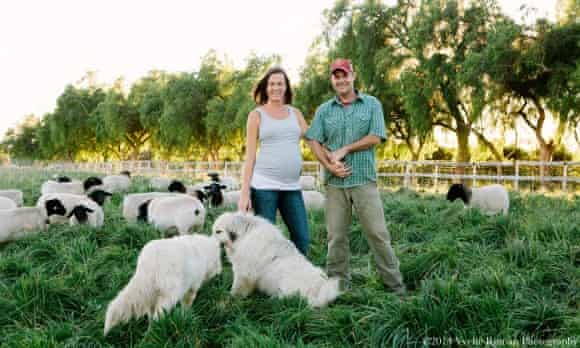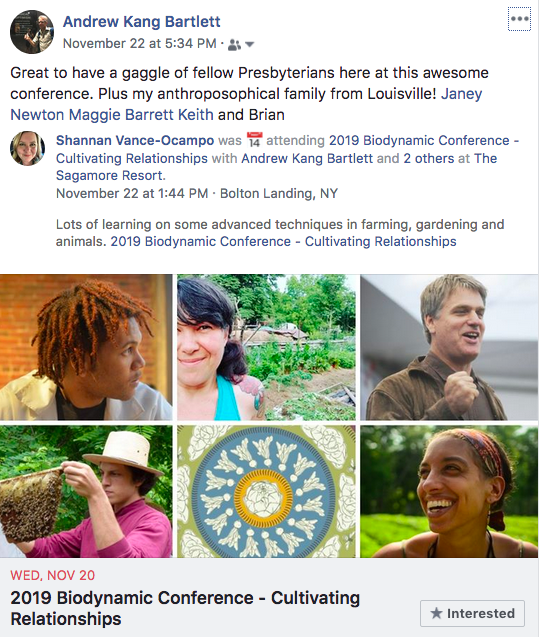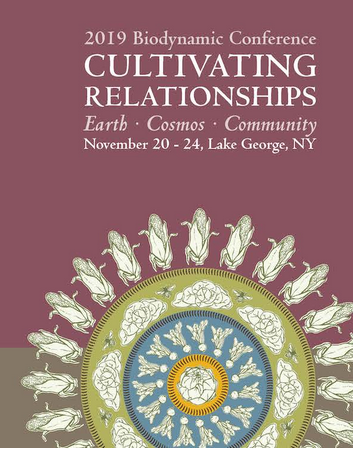Judging by the 900 people at last year’s Biodynamics Conference in Portland and the 700+ assembled in upstate New York this year, biodynamic farming is swelling! Given the high yields of healthy produce, grains and protein and resilience to climate change, the timing of this popularity couldn’t be better.
Our minds and hearts have opened, our souls and spirits are nourished, and our wills are strengthened to continue the sacred work of stewarding land, growing food, and cultivating relationships with Earth, cosmos, and community.
This was a sentiment shared by nearly everyone I spoke with at the conference. There were many first-timers at this year’s gathering and the spiritual foundations of biodynamic agriculture was a prominent theme as people became familiar with the esoteric connections.

Burying cow horns filled with manure. Also known as ‘500’, horn manure spread on the field in a dilute mixture regulates the pH balance of the soil. It stimulates seed germination and root development, in particular vertical growth, increasing depth of root systems It improves the development of leguminous plants (Fabaceae) and nodule formation It helps dissolve minerals even in deep layers (alios) and can helps counteract excessive salt levels. Image credit: Antonio Marxuach/Travel Word
What is biodynamic agriculture?
Austrian philosopher Rudolf Steiner laid out the basis for biodynamics in his lectures in Koberwitz, Germany in 1924. They are known as The Agriculture Course. In the eight lectures, Steiner presents a comprehensive picture of the complex dynamic relationships at work in nature and gives basic indications of the practical measures which are necessary for bringing them into full play.
Biodynamic principles encourage farmers to look to the cosmos before planting and harvesting crops. The biodynamic calendar is based on the positioning of the stars and the moon. Biodynamic certification includes the use of nine “preparations” made from herbs, mineral substances and animal manures that are turned into field sprays and compost. As “far out” as biodynamics may seem to the Western empirical mindset, an increasing number of farmers are adopting biodynamic practices simply based on the positive results.
Presbyterian Presence
I went to my first Biodynamics Conference four years ago when Louisville hosted and then went the next year for the Santa Fe gathering. This year, it was great to have fellow Presbyterian colleagues joining the Lake George conference. They were thrilled and hope to participate in next year’s conference.
Biodynamic Farming also Known as ‘Premium Organic’

Biodynamics, which is akin to agroecological farming, can help farmers adapt to extreme weather and other changes due to climate disruption. Read more here.
There may be biodynamic farms near you and you can find locations on this site. And if you’d like to learn more about biodynamics, see the story of this farm in California.
The Community Guidelines Were a Highlight
The attention on respectful, healthy interactions and relationships at the conference was great to see and I wanted to share them with you. Below are the community guidelines we were asked to reflect on and follow.
With the guidelines posted at eye level in the all-gender rest rooms, we got very familiar with them. I commend them to you for your next gathering! Use or adapt them, with attribution of course.
Biodynamic Conference Community Guidelines
We invite you to join us in co-creating a welcoming and respectful conference culture which supports a rich learning and community building experience for everyone.
-
- Be fully present. Turn off or silence and put away your phone and other devices. Minimize distractions and disruptions for yourself and others. Be here now.
- Give and receive welcome. Say hello. Share a smile.
- Listen deeply. Listen not just to words, but to the feelings, ideas, and inspirations behind them.
- Stay curious and open. Ask questions. Practice inner inquiry. Expect and accept a lack of closure or agreement. Stretch your willingness to be uncomfortable.
- Make space, take space. If you tend to be the last person to speak, consider adding your voice sooner. If you tend to jump in right away, practice patience and listening.
- Share your knowledge, skills, and questions. Don’t expect that we all come with the same language. If you use words or concepts that may be unfamiliar to others, check in to see if an explanation is needed. If you don’t understand something, ask to slow down and clarify. No one knows everything, but together we know a lot.
- Speak from your own experience. Use “I” statements rather than generalizations. As you listen to others, understand that their experiences are unique to them, and your experiences are unique to you. Be aware of your biases and privileges, and allow space for voices that are different from your own.
- Embrace difference and diversity. Practice “yes/and” thinking, exploring how apparently contradictory ideas, observations, or experiences might be true at the same time.
- Respect others’ identities, backgrounds, and boundaries. Listen to how people introduce themselves, look at name badges, and use the names and pronouns that people prefer. Do not assume anyone’s gender identity, cultural background, sexual orientation, or socioeconomic status. Get consent before touching anyone, asking a question like, “May I give you a hug?” and listening carefully to the answer.
- Take care of yourself and each other. Stand up, move around, drink water, step outside, rest. Offer support when you sense it is needed.
- Be aware of both intent and impact. Even though we may intend no harm, sometimes our words and actions can be unskillful and hurt others. Listen to what you actually say, not just what you meant to say. Recognize that impact is often different from intent. If someone tells you that something you said or did caused harm, listen, acknowledge their experience, reflect, and reengage.
- Call each other in, not out. When someone acts in a way that challenges your values, use it as an opportunity to invite or call that person into greater awareness of their impact. Be accepting that you might also be called into acting more skillfully. Let’s all help each other to learn and grow.
These guidelines were co-created by Biodynamic Association staff and the conference advisory committee, with inspiration from Soul Fire Farm, Northeast Sustainable Agriculture Working Group, The People’s Institute for Survival and Beyond, Rural Advancement Foundation International-USA, and Finding Our Voice.
Consider joining the conference next year in November near Boulder, Colorado. Find the dates and subscribe for updates here.


I am in southern Oregon (Myrtle Creek area). I do recycling and have some ground to share with others who are interested in farming. I am also a member of First Presbyterian of Roseburg. My number is 541-643-6823